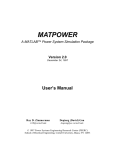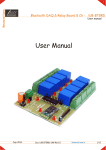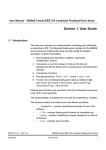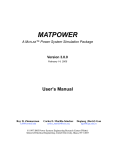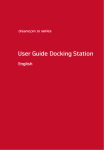Download PowerWeb User`s Manual - Power Systems Engineering Research
Transcript
PSERC 97-10 Cornell • Berkeley • Howard • Illinois • Wisconsin POWERWEB USER’S MANUAL POWER SYSTEMS ENGINEERING RESEARCH CENTER A NATIONAL SCIENCE FOUNDATION I/UCRC CORNELL UNIVERSITY UNIVERSITY OF CALIFORNIA AT B ERKELEY H OWARD UNIVERSITY UNIVERSITY OF ILLINOIS AT URBANA UNIVERSITY OF WISCONSIN AT MADISON Version 1.3 April 1997 1 PSERC 97-10 Acknowledgments This manual was written by Robert J. Thomas at Cornell University with substantial input from Ray Zimmerman, a Visiting Scientist in EE, and Robert Ethier, a graduate student in Ag Economics at Cornell. RJT is responsible for any errors and/or omissions and can be contacted by e-mail at [email protected]. The initial concept of PowerWeb was an idea of Bob Thomas’ but the idea took on reality with the help of Ray Zimmerman and Eric Sakk in December 1995. Ray has done virtually all of the programming and so his name appears (as it should) on the bottom of each PowerWeb page where it says “if you have a problem, write me”. Bob Ethier wrote the majority of Appendix A. The idea of PowerWeb continues to evolve with the help of many people. We have tried to acknowledge contributions to each of the versions and they can be seen by selecting the Credits link on the login page. Current work going on within PSerc is aimed towards the development of a nextgeneration PowerWeb with greater functionality. New versions will be posted on the PowerWeb web-site as soon as they have been alpha-tested. Robert J. Thomas Professor of Electrical Engineering 428 Phillips Hall Cornell University Ithaca, NY 14853 (607) 255-5083 (office) (607) 255-8871 (FAX) [email protected] 2 PSERC 97-10 1.0 Introduction PowerWeb is an environment for testing various power exchange auction markets through tournaments. It is an interactive, distributed and web-based. It is designed to host simulations of a competitive "day-ahead" electric energy market in the context of a deregulated electric power industry. In the current implementation of PowerWeb, an Independent System Operator (ISO) receives offers to sell power from independently owned generation facilities. Based on the forecasted load profile for the next day and the information gathered from the generators’ offers, the ISO computes the optimal generator set points along with a corresponding price schedule which will allow the system to meet the changing load while satisfying all of the operational constraints. The ISO computes a dispatch and price schedule based on the submitted offers. The prices for each generator are locational, that is, they are adjusted for losses and congestion. The ISO has access to the same system information as everyone else, plus the complete dispatch schedule (generators only see their own dispatch info). In this environment, the ISO triggers the recomputation of the dispatch at the times specified by the rules of the auction. 2.0 Power Web Access and Links What hardware and software is needed? Since PowerWeb is web-based, a web browser will be needed. PowerWeb uses several advanced features present in browsers such as Netscape 3.0. These include frames, Java applets, and JavaScript. PowerWeb can be accessed from any platform (PC, Mac, or any Unix box) where there is an appropriate browser installed. The URL The PowerWeb Main Menu may be accessed at the following URL: http://www.pserc.cornell.edu/powerweb/ Select the Go to P OWERWEB link. Now select Login. A user name and password are needed in order to log in to PowerWeb. These will be provided by Cornell University. After entering a valid username and password, the user is asked to select a from a list of game sessions which one they would like to participate in. The user is now fully logged in and can begin to participate in the market to sell power. Upon successfully logging in as one of the generators, the following web links (shown in bold at the top of the screen) are available to the user: 3 PSERC 97-10 Description Describes the links available at the top of the screen. Market Presents a menu of options, allowing you to view market information. If you are representing one of the generators, you can view the costs and constraints on your generator, submit offers to sell generation, and review the power dispatch, price, revenue and profit schedules resulting from your offers. System Info Presents a menu of options allowing you to view the system map, system parameters, and operating conditions for each dispatch period. Logout Exits the current PowerWeb session. The options available under the Market page are as follows: Description Links to above Description page. Main Auction Page (for each dispatch period) Allows you to submit a new offer to sell power. Displays a summary of the status of your offer and the ISO's response to that offer. The offer submission form allows you to enter quantities and prices for several blocks of power. When the “Submit New Offer” button is pressed, the new offer will be displayed graphically, along with cost data, in the applet below the offer form. A status summary table to the right of the form displays the new dispatch for the generator, the total system load, the price to be received by the generator and the price at a fixed reference bus. It also displays the revenue, production cost, startup cost and profit for the generator for this dispatch period. Below the graphical display of the offer and costs is a table with generator constraint information and a table summarizing the status of offers submitted by this generator for this dispatch period. The “Submitted” column displays the last offer submitted to the ISO, which is the same as the one displayed graphically. The column labeled “Processed” is the complete information on the last offer processed by the ISO. This offer is the one that generated the currently displayed dispatch and pricing information. The column labeled “Accepted” simply displays the portion of the “Processed” offer that was included in the most recent dispatch, along with the price to be paid for the accepted units. 4 PSERC 97-10 Market Summary Displays a summary of the dispatch, price, revenue, cost, and profit schedules for each time period based on the most recent set of accepted offers. 5 PSERC 97-10 Generator Info Links to page detailing generator cost information and grid information. The options available under the System Info page are as follows: Description Links to above Description page. System Map Links to a map of the full 30 node / 6 generator system. The one line diagram contains clickable transmission lines which provide the details of the transmission grid. Summary Data Links to a page which summarizes grid information. 3.0 Instructions For a Uniform Price Electric Power Auction The following set of instructions define the “rules of the game” under which the competition will be run and the winners and losers judged. The following instructions are for the Uniform Price auction developed at Cornell. Note, experimental economists believe there has to be real money on the table before true behavior is revealed. The Instructions This is an experiment in the economics of decision making. Please read these instructions carefully and do not hesitate to ask if you have a question. Your objective is to earn as much money as you can. Participants will be ranked by the percentage of profit earned relative to the profit that would be earned in a competitive market. The Experiment In this experiment you will be a generator selling electric power to an Independent System Operator (ISO). The ISO controls the electric grid over which power is transmitted, and sells power to all of the demand nodes on the grid. The experiment will take place in periods. There will be three (3) periods in the experiment, with each period determining the dispatch for an hour of electricity. The first period will be a practice period. Its results will not count toward the final profit totals. In each period you, and each of the other participants, will sell the output of an electric power plant. Each participant has his or her own power plant. You will sell the output in an auction where the total amount of electricity to be bought is predetermined, although the number may change from period to period. 6 PSERC 97-10 3500 3000 c(Pg) ($/MW) 2500 2000 1500 1000 500 0 0 10 20 30 40 50 60 Pg (MW) 70 80 90 100 Figure 1A: A Generator's Total Cost Curve At the beginning of each period you will be shown a graph similar to the one shown in Figure 1A. Figure 1A shows the Total Costs of operating the generator for a given output level. Total costs include both fixed and variable costs. Fixed costs include personnel, maintenance costs, and capital costs. The marginal cost curve for the generator is shown in Figure 2A. It is the derivative of the actual cost curve and shows the cost of generating the next incremental MW of power which is primarily fuel cost. That is, the incremental cost represents the increase in cost per increase in MW. Note that since actual generator cost curves are approximately quadratic, incremental cost curves are approximately linear. Both the Total and Marginal Cost curves are shown on the Main Auction page. 50 45 40 mc(Pg) ($/MWh) 35 30 25 20 15 10 5 0 0 10 20 30 40 50 60 Pg (MW) 7 70 80 90 100 PSERC 97-10 Figure 2A: A marginal cost curve For each unit you sell, the profit earned (sale price minus cost) will be added to your earnings. Note: you do not need to sell all of the units which you are provided with, as the cost of each unit is deducted from your earnings only if it is sold. How a Period Works Each period will consist of 5 iterations, with each iteration resulting in a dispatch schedule and price. The first four iterations result in tentative schedules and prices, used to provide preliminary outcomes to market participants. The fifth and final iteration provides the actual dispatch for the period. Each iteration in the experiment will last 3 minutes. At any time before the iteration is over, you, the seller, may submit an offer to sell any portion of the output of your power plant by submitting one of the provided Offer Sheets. A sample Offer Sheet is shown below in Figure 3A. Figure 3A: A PowerWeb form for offering quantity and price Note that offers must be in the form of blocks representing quantity and price. When filling out an Offer Sheet, you may submit up to 5 blocks of power. Each block may be of a different size and have a different price. The cheapest block must be at least as large as the minimum generation level shown on your marginal cost curve. The sum of the blocks must be less than or equal to the total amount of energy your power plant is capable of generating. You may change the blocks and prices by updating your existing offer sheet and resubmitting your offers until the iteration ends. The most recent submission is used to compute the tentative dispatch. Since the ISO has no way of knowing the true capacity of a generator, it is possible to submit an offer to generate more than is physically available from a generator. However, if it were accepted, the generator would be contractually obligated to find 8 PSERC 97-10 the additional MW’s at whatever price he could. The alternative would be to default on his contract and face severe penalties. The current version of PowerWeb warns the user but does not include any penalties. How Blocks of Power Are Selected and Prices Determined In this game, all electricity is purchased by the Independent System Operator (ISO). The ISO’s job is to select and dispatch generators based on their submitted offers so that the demand on the grid is satisfied at least cost. A diagram of a sample grid that will be used for the tournament is shown in Figure 4A. Figure 4A: A sample 6-machine 30-bus power system One can think of the Independent System Operator as determining both the selected offers (purchased units of power) and the price received for the electricity in this way: the submitted offers are entered into a computer, where they are rank ordered from lowest to highest price. The System Operator selects the cheapest blocks of power, the total of which equal the total system demand. All offers above the cutoff are rejected. All units which are sold receive the Reigning Price, which is the price of the 1st rejected offer. 9 PSERC 97-10 Figure 5A shows how the offer curve and demand for electricity would determine the Reigning Price, as well as which blocks of electricity would be sold. Because of the nature of the grid, part of a submitted block of power will often be selected. In this event, the Reigning Price is set by the 1st completely rejected block of power. This is also illustrated in the figure. If the submitted supply is insufficient to satisfy demand, loads are randomly eliminated until supply is sufficient to satisfy the remaining loads plus losses. The Reigning price is set to $500/MWh plus the largest locational price adjustment (losses plus congestion). All offers above $500/MWh are rejected. Figure 5A: Offers for blocks of generation ranked in order of increasing price ($/MWh). Incorporating an Electric Grid In reality, the System Operator's decision is somewhat more complicated. As shown earlier, electricity is transmitted to users through a grid or network of wires. As electricity flows through the wires, some of its energy is lost as heat, creating transmission losses. The size of these losses depends not only on characteristics of the wires, but on the location and dispatch of the committed power plants, and the location and magnitude of the demand for electricity. Every MW of power flowing over the grid causes some losses, and the loss associated with each MW is different. When the System Operator selects generators to produce power, it takes into account transmission losses. In some instances, a less expensive generator might create enough extra transmission losses to warrant choosing the next most expensive generator. Since the losses associated with each unit of power can be computed, and a price can be attached to the losses, the System Operator can actually select generators based on their offer plus a generator-specific loss charge. This can be thought of as adding a charge on top of each offered unit, rank ordering the loss adjusted blocks of electricity, and using the new adjusted cost of each offer to achieve the lowest cost dispatch. The Reigning Price is still the price of the 1st rejected offer, 10 PSERC 97-10 but now it includes transmission losses. The price received by each block becomes the Reigning Price minus the appropriate transmission losses for each unit of power. There is one further complication. Each transmission line has a maximum carrying capacity. When this capacity is exceeded and a line is congested, the lines begin to sag and ultimately even melt. To run a reliable electricity grid, this must be avoided. The only way that this can be avoided is by reducing the output of generators which feed large amounts of electricity into the overburdened line and increasing the output of generators which feed little of their energy into that line. When a line is congested, a cost can be computed for each unit of electricity flowing over that line. That cost can be assigned to a specific generator and used to adjust the offer price of each block, similar to what was done with transmission losses. The primary difference is that congestion prices are likely to vary greatly across generators and with different demand patterns. Note that neither losses nor congestion can be computed precisely ahead of time. Only after offers are submitted to the ISO can the ISO calculate the appropriate losses and congestion charges for each generator. This is why the auction is iterated. Figure 6A below shows offers combined with both transmission loss adjustments and congestion pricing. This is how the Independent System Operator actually chooses blocks of power. Figure 6A: Price adjustments to offers based on system conditions. The price received by each generator is the Reigning price (λ REF) minus the appropriate price adjustment. This is always greater than that generator’s offer price. The End of an Iteration 11 PSERC 97-10 When the iteration ends after 3 minutes, no more Offer Sheets may be submitted. The System Operator chooses the lowest priced blocks of energy, where the price includes both transmission loss adjustments and congestion prices. Generator dispatch points and prices are then posted. If there are remaining iterations, new offer sheets are submitted. If this is the end of the fifth and final iteration, the selected blocks are purchased at the Reigning price, minus location specific adjustments. Profits are automatically calculated and posted. If we have not completed all three periods, new Offer Sheets will be posted. If we are at the completion of the third period, earnings will be totaled and provided manually. How Profits Are Computed Profits are the difference between revenue and costs. Of course, the object from the point of view of a generator is to maximize profits. From the point of view of the ISO the objective is to cause everyone to reveal true costs plus enough of the supply curve to be useful for planning purposes. Note that costs are incurred only when a unit of electricity is sold. Generators will be ranked by the percentage of expected profit achieved in the final two periods, where the expected profit is the profit which would have been earned in a competitive market. 12













